Jiazheng Wang
Gaussian Primitive Optimized Deformable Retinal Image Registration
Aug 23, 2025Abstract:Deformable retinal image registration is notoriously difficult due to large homogeneous regions and sparse but critical vascular features, which cause limited gradient signals in standard learning-based frameworks. In this paper, we introduce Gaussian Primitive Optimization (GPO), a novel iterative framework that performs structured message passing to overcome these challenges. After an initial coarse alignment, we extract keypoints at salient anatomical structures (e.g., major vessels) to serve as a minimal set of descriptor-based control nodes (DCN). Each node is modelled as a Gaussian primitive with trainable position, displacement, and radius, thus adapting its spatial influence to local deformation scales. A K-Nearest Neighbors (KNN) Gaussian interpolation then blends and propagates displacement signals from these information-rich nodes to construct a globally coherent displacement field; focusing interpolation on the top (K) neighbors reduces computational overhead while preserving local detail. By strategically anchoring nodes in high-gradient regions, GPO ensures robust gradient flow, mitigating vanishing gradient signal in textureless areas. The framework is optimized end-to-end via a multi-term loss that enforces both keypoint consistency and intensity alignment. Experiments on the FIRE dataset show that GPO reduces the target registration error from 6.2\,px to ~2.4\,px and increases the AUC at 25\,px from 0.770 to 0.938, substantially outperforming existing methods. The source code can be accessed via https://github.com/xintian-99/GPOreg.
ShorterBetter: Guiding Reasoning Models to Find Optimal Inference Length for Efficient Reasoning
Apr 30, 2025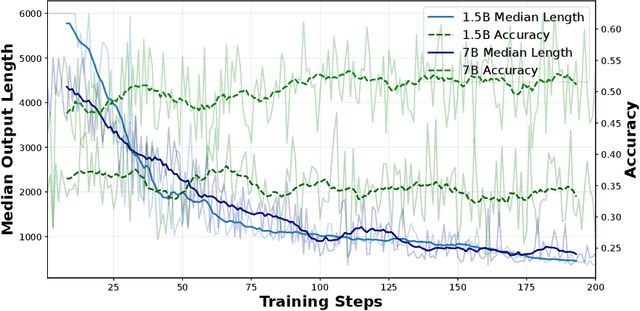

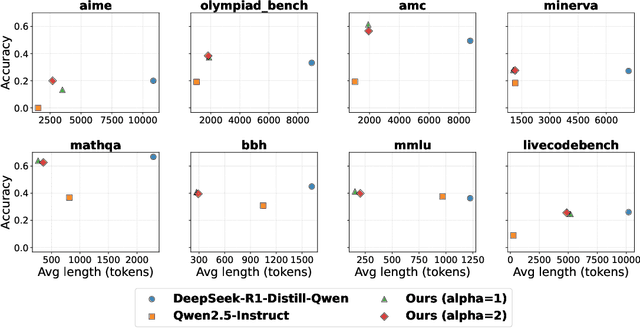

Abstract:Reasoning models such as OpenAI o3 and DeepSeek-R1 have demonstrated strong performance on reasoning-intensive tasks through extended Chain-of-Thought (CoT) prompting. While longer reasoning traces can facilitate a more thorough exploration of solution paths for complex problems, researchers have observed that these models often "overthink", leading to inefficient inference. In this paper, we introduce ShorterBetter, a simple yet effective reinforcement learning methed that enables reasoning language models to discover their own optimal CoT lengths without human intervention. By sampling multiple outputs per problem and defining the Sample Optimal Length (SOL) as the shortest correct response among all the outputs, our method dynamically guides the model toward optimal inference lengths. Applied to the DeepSeek-Distill-Qwen-1.5B model, ShorterBetter achieves up to an 80% reduction in output length on both in-domain and out-of-domain reasoning tasks while maintaining accuracy. Our analysis shows that overly long reasoning traces often reflect loss of reasoning direction, and thus suggests that the extended CoT produced by reasoning models is highly compressible.
Reproducibility Assessment of Magnetic Resonance Spectroscopy of Pregenual Anterior Cingulate Cortex across Sessions and Vendors via the Cloud Computing Platform CloudBrain-MRS
Mar 06, 2025



Abstract:Given the need to elucidate the mechanisms underlying illnesses and their treatment, as well as the lack of harmonization of acquisition and post-processing protocols among different magnetic resonance system vendors, this work is to determine if metabolite concentrations obtained from different sessions, machine models and even different vendors of 3 T scanners can be highly reproducible and be pooled for diagnostic analysis, which is very valuable for the research of rare diseases. Participants underwent magnetic resonance imaging (MRI) scanning once on two separate days within one week (one session per day, each session including two proton magnetic resonance spectroscopy (1H-MRS) scans with no more than a 5-minute interval between scans (no off-bed activity)) on each machine. were analyzed for reliability of within- and between- sessions using the coefficient of variation (CV) and intraclass correlation coefficient (ICC), and for reproducibility of across the machines using correlation coefficient. As for within- and between- session, all CV values for a group of all the first or second scans of a session, or for a session were almost below 20%, and most of the ICCs for metabolites range from moderate (0.4-0.59) to excellent (0.75-1), indicating high data reliability. When it comes to the reproducibility across the three scanners, all Pearson correlation coefficients across the three machines approached 1 with most around 0.9, and majority demonstrated statistical significance (P<0.01). Additionally, the intra-vendor reproducibility was greater than the inter-vendor ones.
EndoChat: Grounded Multimodal Large Language Model for Endoscopic Surgery
Jan 20, 2025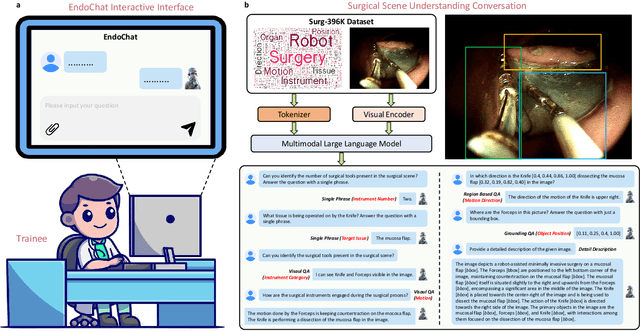

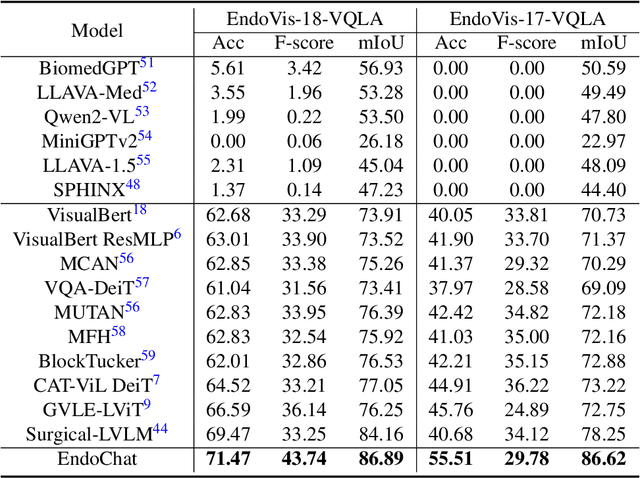
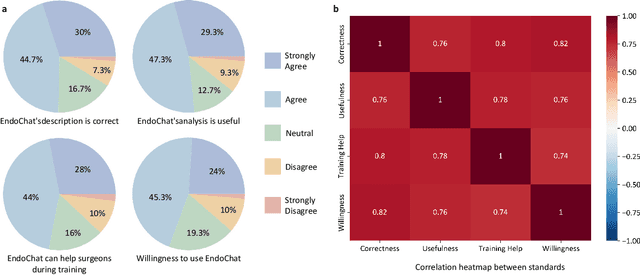
Abstract:Recently, Multimodal Large Language Models (MLLMs) have demonstrated their immense potential in computer-aided diagnosis and decision-making. In the context of robotic-assisted surgery, MLLMs can serve as effective tools for surgical training and guidance. However, there is still a lack of MLLMs specialized for surgical scene understanding in clinical applications. In this work, we introduce EndoChat to address various dialogue paradigms and subtasks in surgical scene understanding that surgeons encounter. To train our EndoChat, we construct the Surg-396K dataset through a novel pipeline that systematically extracts surgical information and generates structured annotations based on collected large-scale endoscopic surgery datasets. Furthermore, we introduce a multi-scale visual token interaction mechanism and a visual contrast-based reasoning mechanism to enhance the model's representation learning and reasoning capabilities. Our model achieves state-of-the-art performance across five dialogue paradigms and eight surgical scene understanding tasks. Additionally, we conduct evaluations with professional surgeons, most of whom provide positive feedback on collaborating with EndoChat. Overall, these results demonstrate that our EndoChat has great potential to significantly advance training and automation in robotic-assisted surgery.
Enhancing Transformers for Generalizable First-Order Logical Entailment
Jan 01, 2025



Abstract:Transformers, as a fundamental deep learning architecture, have demonstrated remarkable capabilities in reasoning. This paper investigates the generalizable first-order logical reasoning ability of transformers with their parameterized knowledge and explores ways to improve it. The first-order reasoning capability of transformers is assessed through their ability to perform first-order logical entailment, which is quantitatively measured by their performance in answering knowledge graph queries. We establish connections between (1) two types of distribution shifts studied in out-of-distribution generalization and (2) the unseen knowledge and query settings discussed in the task of knowledge graph query answering, enabling a characterization of fine-grained generalizability. Results on our comprehensive dataset show that transformers outperform previous methods specifically designed for this task and provide detailed empirical evidence on the impact of input query syntax, token embedding, and transformer architectures on the reasoning capability of transformers. Interestingly, our findings reveal a mismatch between positional encoding and other design choices in transformer architectures employed in prior practices. This discovery motivates us to propose a more sophisticated, logic-aware architecture, TEGA, to enhance the capability for generalizable first-order logical entailment in transformers.
Fidelity-Imposed Displacement Editing for the Learn2Reg 2024 SHG-BF Challenge
Oct 28, 2024



Abstract:Co-examination of second-harmonic generation (SHG) and bright-field (BF) microscopy enables the differentiation of tissue components and collagen fibers, aiding the analysis of human breast and pancreatic cancer tissues. However, large discrepancies between SHG and BF images pose challenges for current learning-based registration models in aligning SHG to BF. In this paper, we propose a novel multi-modal registration framework that employs fidelity-imposed displacement editing to address these challenges. The framework integrates batch-wise contrastive learning, feature-based pre-alignment, and instance-level optimization. Experimental results from the Learn2Reg COMULISglobe SHG-BF Challenge validate the effectiveness of our method, securing the 1st place on the online leaderboard.
Unsupervised Multimodal 3D Medical Image Registration with Multilevel Correlation Balanced Optimization
Sep 08, 2024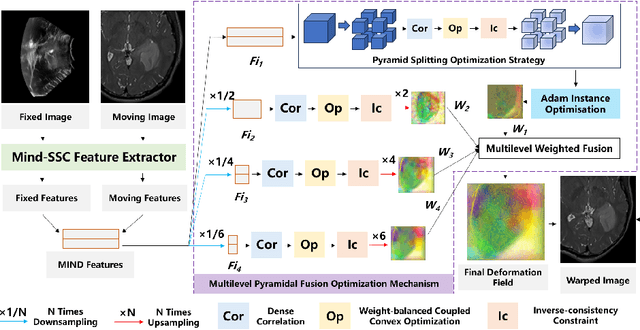
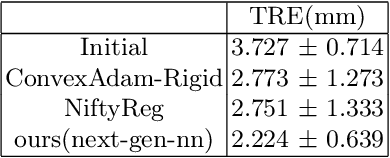
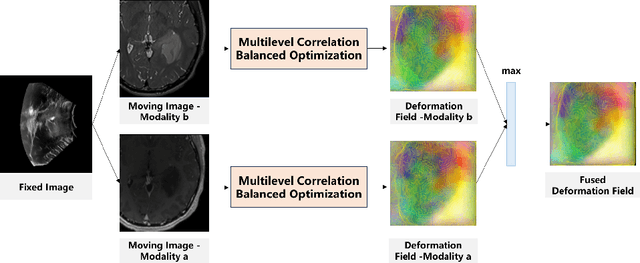

Abstract:Surgical navigation based on multimodal image registration has played a significant role in providing intraoperative guidance to surgeons by showing the relative position of the target area to critical anatomical structures during surgery. However, due to the differences between multimodal images and intraoperative image deformation caused by tissue displacement and removal during the surgery, effective registration of preoperative and intraoperative multimodal images faces significant challenges. To address the multimodal image registration challenges in Learn2Reg 2024, an unsupervised multimodal medical image registration method based on multilevel correlation balanced optimization (MCBO) is designed to solve these problems. First, the features of each modality are extracted based on the modality independent neighborhood descriptor, and the multimodal images is mapped to the feature space. Second, a multilevel pyramidal fusion optimization mechanism is designed to achieve global optimization and local detail complementation of the deformation field through dense correlation analysis and weight-balanced coupled convex optimization for input features at different scales. For preoperative medical images in different modalities, the alignment and stacking of valid information between different modalities is achieved by the maximum fusion between deformation fields. Our method focuses on the ReMIND2Reg task in Learn2Reg 2024, and to verify the generality of the method, we also tested it on the COMULIS3DCLEM task. Based on the results, our method achieved second place in the validation of both two tasks.
Large Scale Unsupervised Brain MRI Image Registration Solution for Learn2Reg 2024
Sep 04, 2024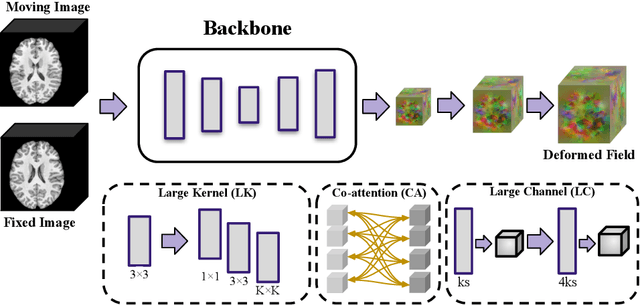


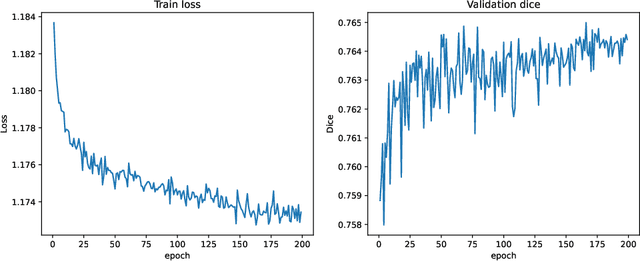
Abstract:In this paper, we summarize the methods and experimental results we proposed for Task 2 in the learn2reg 2024 Challenge. This task focuses on unsupervised registration of anatomical structures in brain MRI images between different patients. The difficulty lies in: (1) without segmentation labels, and (2) a large amount of data. To address these challenges, we built an efficient backbone network and explored several schemes to further enhance registration accuracy. Under the guidance of the NCC loss function and smoothness regularization loss function, we obtained a smooth and reasonable deformation field. According to the leaderboard, our method achieved a Dice coefficient of 77.34%, which is 1.4% higher than the TransMorph. Overall, we won second place on the leaderboard for Task 2.
One for Multiple: Physics-informed Synthetic Data Boosts Generalizable Deep Learning for Fast MRI Reconstruction
Jul 25, 2023
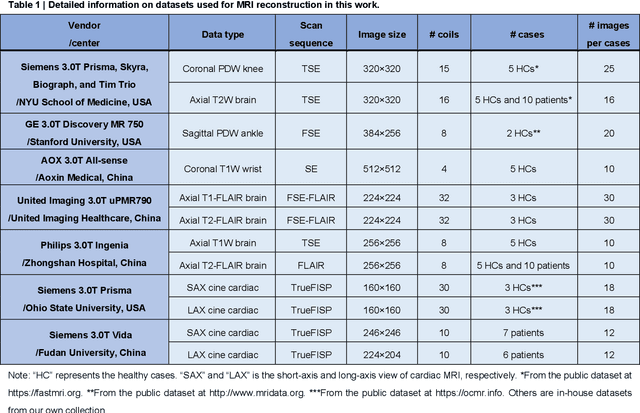
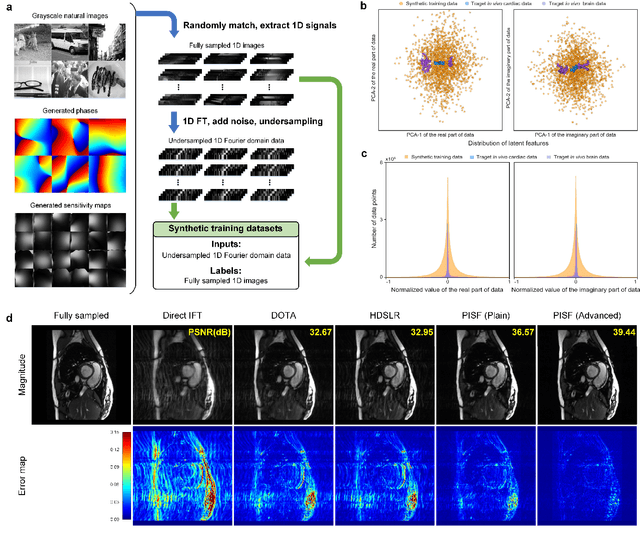
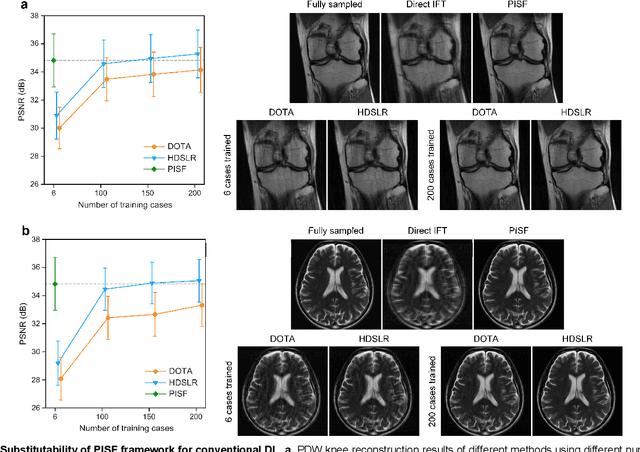
Abstract:Magnetic resonance imaging (MRI) is a principal radiological modality that provides radiation-free, abundant, and diverse information about the whole human body for medical diagnosis, but suffers from prolonged scan time. The scan time can be significantly reduced through k-space undersampling but the introduced artifacts need to be removed in image reconstruction. Although deep learning (DL) has emerged as a powerful tool for image reconstruction in fast MRI, its potential in multiple imaging scenarios remains largely untapped. This is because not only collecting large-scale and diverse realistic training data is generally costly and privacy-restricted, but also existing DL methods are hard to handle the practically inevitable mismatch between training and target data. Here, we present a Physics-Informed Synthetic data learning framework for Fast MRI, called PISF, which is the first to enable generalizable DL for multi-scenario MRI reconstruction using solely one trained model. For a 2D image, the reconstruction is separated into many 1D basic problems and starts with the 1D data synthesis, to facilitate generalization. We demonstrate that training DL models on synthetic data, integrated with enhanced learning techniques, can achieve comparable or even better in vivo MRI reconstruction compared to models trained on a matched realistic dataset, reducing the demand for real-world MRI data by up to 96%. Moreover, our PISF shows impressive generalizability in multi-vendor multi-center imaging. Its excellent adaptability to patients has been verified through 10 experienced doctors' evaluations. PISF provides a feasible and cost-effective way to markedly boost the widespread usage of DL in various fast MRI applications, while freeing from the intractable ethical and practical considerations of in vivo human data acquisitions.
Magnetic Resonance Spectroscopy Quantification Aided by Deep Estimations of Imperfection Factors and Overall Macromolecular Signal
Jun 16, 2023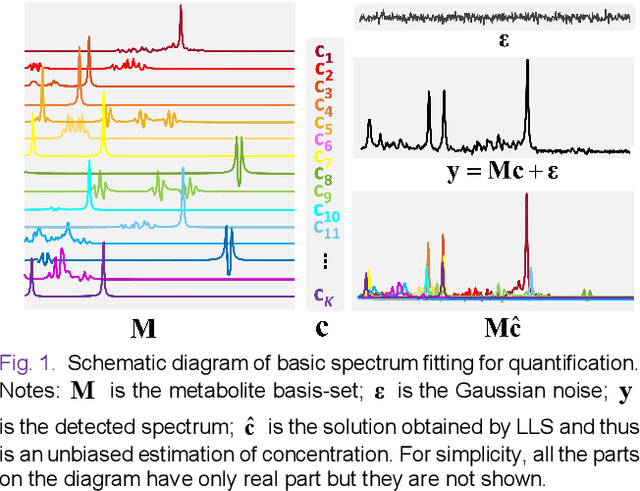
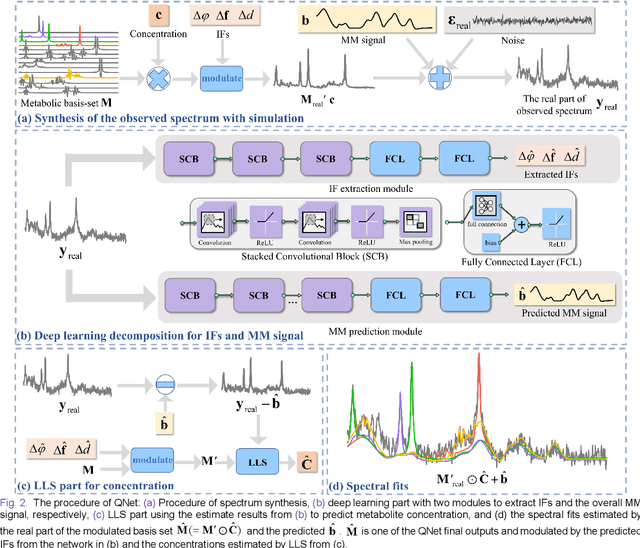
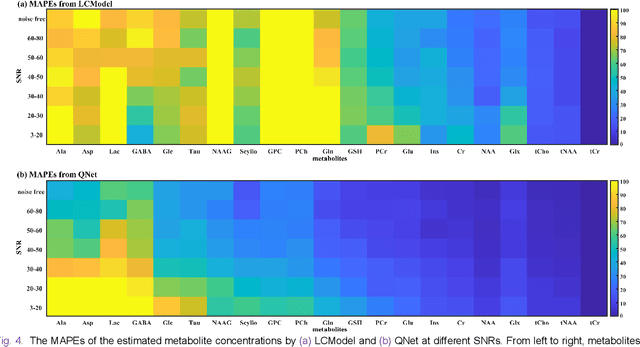
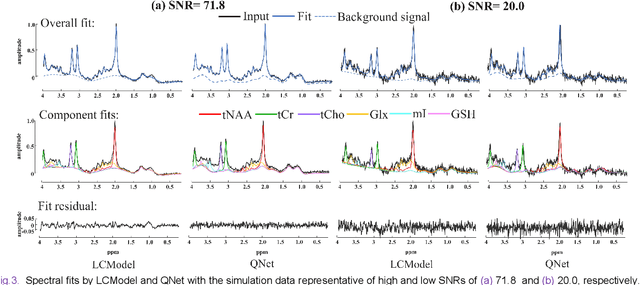
Abstract:Magnetic Resonance Spectroscopy (MRS) is an important non-invasive technique for in vivo biomedical detection. However, it is still challenging to accurately quantify metabolites with proton MRS due to three problems: Serious overlaps of metabolite signals, signal distortions due to non-ideal acquisition conditions and interference with strong background signals including macromolecule signals. The most popular software, LCModel, adopts the non-linear least square to quantify metabolites and addresses these problems by introducing regularization terms, imperfection factors of non-ideal acquisition conditions, and designing several empirical priors such as basissets of both metabolites and macromolecules. However, solving such a large non-linear quantitative problem is complicated. Moreover, when the signal-to-noise ratio of an input MRS signal is low, the solution may have a large deviation. In this work, deep learning is introduced to reduce the complexity of solving this overall quantitative problem. Deep learning is designed to predict directly the imperfection factors and the overall signal from macromolecules. Then, the remaining part of the quantification problem becomes a much simpler effective fitting and is easily solved by Linear Least Squares (LLS), which greatly improves the generalization to unseen concentration of metabolites in the training data. Experimental results show that compared with LCModel, the proposed method has smaller quantification errors for 700 sets of simulated test data, and presents more stable quantification results for 20 sets of healthy in vivo data at a wide range of signal-to-noise ratio. Qnet also outperforms other deep learning methods in terms of lower quantification error on most metabolites. Finally, QNet has been deployed on a cloud computing platform, CloudBrain-MRS, which is open accessed at https://csrc.xmu.edu.cn/CloudBrain.html.
 Add to Chrome
Add to Chrome Add to Firefox
Add to Firefox Add to Edge
Add to Edge